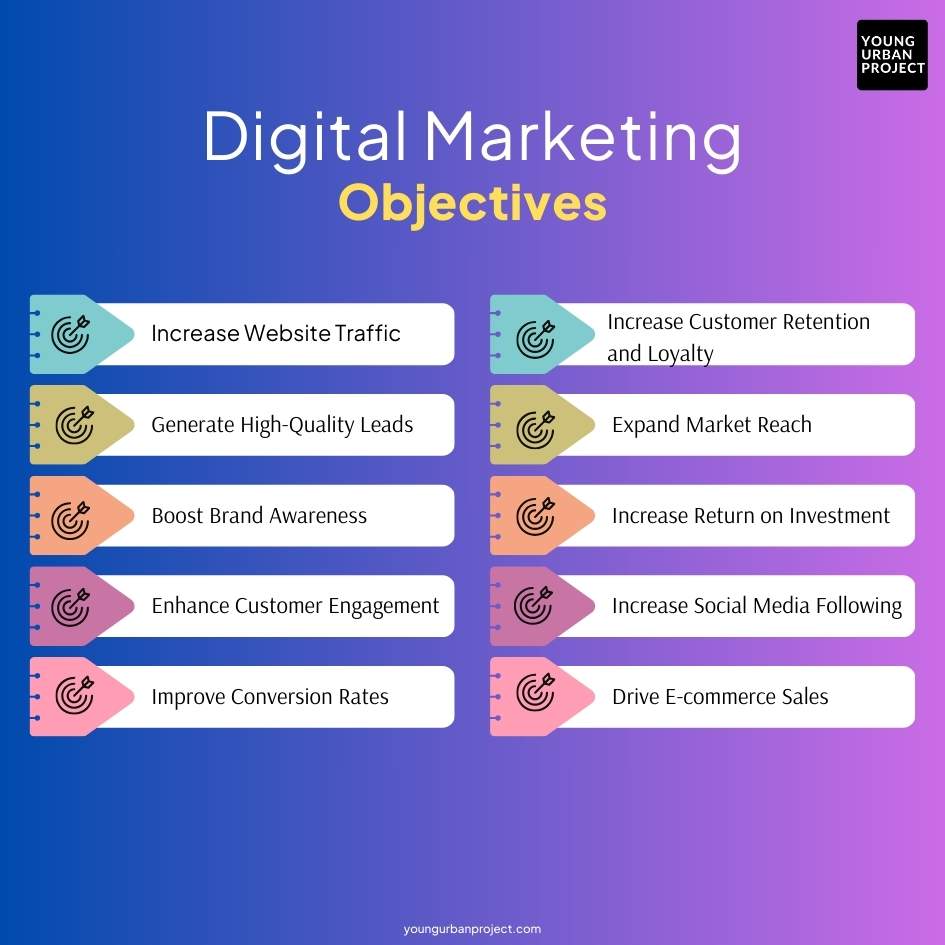Businesses need a clear and strategic approach to their online presence today. At the core of every successful strategy lies a set of well-defined digital marketing objectives. These objectives provide direction, help track progress, and ensure that marketing efforts deliver measurable results. Whether you’re a startup or an established brand, understanding and setting these objectives is crucial to your long-term success.
This blog will explore 10 critical digital marketing objectives that every business should focus on to maximize its impact and reach online.
What Are Digital Marketing Objectives?
Digital marketing objectives refer to specific, measurable goals that a business aims to achieve through online marketing channels. These goals can range from increasing website traffic to generating more leads, enhancing brand awareness, or boosting conversion rates. Objectives provide a clear roadmap for your digital marketing strategy, ensuring that every action you take aligns with your overall business goals.
10 Most Important Digital Marketing Objectives

1. Increase Website Traffic
One of the most fundamental digital marketing objectives is driving traffic to your website. After all, your website serves as the central hub where prospects and customers can engage with your brand, learn about your products or services, and make purchases.
To achieve this objective, businesses leverage tactics such as:
- SEO (Search Engine Optimization): Ensuring that your website ranks well on search engines like Google for relevant keywords.
- Content Marketing: Creating valuable blog posts, videos, infographics, and other content that attracts your target audience.
- Social Media: Sharing content on platforms like Instagram, LinkedIn, and Facebook to draw people to your site.
Measuring website traffic is relatively simple with tools like Google Analytics, where you can track the number of visitors, pages they visit, and how long they stay on your site.
2. Generate High-Quality Leads
Generating leads is a primary objective for most digital marketers. A lead is someone who shows interest in your product or service by taking action, such as filling out a form, downloading a resource, or signing up for a webinar. High-quality leads are more likely to convert into paying customers, making this objective essential for long-term revenue growth.
Some effective ways to generate leads through digital marketing include:
- Offering free content like eBooks or guides in exchange for an email address.
- Hosting webinars on relevant industry topics.
- Running PPC campaigns (Pay-per-click ads) to capture interest from people searching for specific solutions.
Make sure you track metrics like lead form completions and cost-per-lead to gauge the effectiveness of your efforts.
3. Boost Brand Awareness
Building strong brand awareness ensures that your business stays top of mind for potential customers. When people recognize your brand and associate it with a particular solution, they are more likely to engage with it, recommend it, or become loyal customers over time.
To achieve this objective, you can focus on:
- Social media engagement: Consistently posting and interacting with followers.
- Influencer marketing: Partnering with influential figures in your industry to promote your products.
- Content sharing: Creating shareable, high-value content like infographics, videos, and blog posts.
Remember, increasing brand awareness is about long-term engagement, not immediate conversions. Tools like social listening platforms and engagement metrics on social media can help track brand visibility.
4. Enhance Customer Engagement
Engagement involves direct interaction between your brand and its audience. This could be through likes, comments, shares, or discussions across social media platforms or interactions via email. Customer engagement is critical because it strengthens relationships, fosters loyalty, and encourages customers to act as advocates for your brand.
Here are a few strategies to boost engagement:
- Interactive content: Polls, quizzes, and live Q&A sessions.
- Personalized email marketing: Tailoring email content to address specific customer pain points or preferences.
- Loyalty programs: Offering rewards or incentives for active customers.
Tracking customer engagement can be done via metrics like social media shares, comments, or email open rates.
5. Improve Conversion Rates
Conversion rate optimization (CRO) is one of the most important digital marketing objectives. Simply put, it’s the process of turning website visitors into customers. A high conversion rate means that your website is effectively persuading visitors to take action, whether that’s making a purchase, signing up for a newsletter, or filling out a contact form.
To boost your conversion rates:
- A/B Testing: Experiment with different layouts, calls-to-action, and content to see what performs best.
- Clear CTAs (Call-to-actions): Use persuasive language and position CTAs where they’re easily visible.
- Optimize landing pages: Ensure your landing pages are well-designed and provide value to the visitor.
Tools like Google Optimize or Optimizely can be used to test different strategies and track improvements in conversion rates.
Also Read: Advanced Performance Marketing Bootcamp
6. Increase Customer Retention and Loyalty
While acquiring new customers is essential, retaining existing ones is equally crucial. Repeat customers tend to spend more over time, and customer loyalty can significantly impact a business’s long-term profitability. This objective focuses on fostering lasting relationships and encouraging repeat purchases.
To improve customer retention:
- Email marketing: Send personalized offers, product recommendations, or follow-ups.
- Customer support: Offer excellent post-purchase support to resolve issues quickly.
- Loyalty programs: Reward repeat customers with exclusive deals or bonuses.
Measuring retention can be done using customer lifetime value (CLV) and repeat purchase rates.

CheckOut: Digital Marketing Course in Chandigarh
7. Expand Market Reach
Expanding your market reach is a critical digital marketing objective for businesses aiming for growth. This means increasing your visibility to new audiences, potentially entering new markets, or targeting previously untapped customer segments.
To achieve this:
- Paid advertising: Run targeted ads on search engines and social media platforms to reach new audiences.
- Localization: Tailor your content to fit the cultural and linguistic preferences of different regions.
- Partnerships and collaborations: Work with other businesses or influencers in different markets to expand your reach.
Expanding market reach can be tracked through metrics such as the number of new users visiting your site or the geographic diversity of your audience.
8. Increase Return on Investment (ROI)
Another important digital marketing objective is ensuring that your marketing campaigns generate a high return on investment. ROI measures the efficiency of your digital marketing efforts—how much revenue you earn compared to how much you spend.
To maximize ROI:
- Data-driven decisions: Use analytics to make informed decisions and optimize campaigns in real-time.
- Focus on high-performing channels: Allocate more budget to the channels driving the most conversions.
- Automate processes: Leverage automation tools to save time and reduce marketing costs.
By tracking ROI using tools like Google Analytics and ROI calculators, you can refine your strategy to ensure that each dollar spent is generating maximum returns.
9. Increase Social Media Following
Having a substantial social media following can amplify your brand’s message and help establish credibility. Growing your follower base should be a focused digital marketing objective because a larger audience means more people engaging with your content, sharing your posts, and ultimately, becoming customers.
To grow your social media following:
- Consistent posting: Keep a regular schedule for content that resonates with your audience.
- Engage with followers: Reply to comments, like posts, and foster conversations.
- Run giveaways or contests: Encourage people to follow your account in exchange for a chance to win something valuable.
Measure your progress through follower growth metrics, engagement rates, and reach.
10. Drive E-commerce Sales
For businesses that sell products online, increasing e-commerce sales is a primary objective. Digital marketing plays a huge role in driving traffic to e-commerce websites, encouraging visitors to make purchases, and improving overall sales figures.
Key strategies to drive e-commerce sales include:
- Product retargeting ads: Remind people who have visited your site but haven’t made a purchase about your products.
- Email campaigns: Send cart abandonment emails to prompt customers to complete their purchase.
- Seasonal promotions: Leverage holidays, sales, or special events to encourage buying.
Track this objective using key performance indicators (KPIs) such as sales revenue, average order value, and conversion rates.
Conclusion
Digital marketing objectives are vital to driving business growth, and each goal helps steer your strategy in a clear, measurable direction. From increasing traffic to enhancing customer loyalty, your objectives should be tailored to your business needs and regularly revisited to ensure optimal performance. By focusing on the 10 objectives mentioned above, you can lay a strong foundation for a successful digital marketing strategy.
Whether you’re a small business or an established enterprise, setting clear digital marketing objectives ensures that your online efforts are aligned with your broader business goals. Start by choosing the objectives that align most closely with your current needs, and measure your progress to keep improving over time.
What are digital marketing objectives?
Digital marketing objectives are specific, measurable goals that a business aims to achieve through online marketing efforts. These objectives guide the strategy, helping to focus on key areas such as increasing traffic, generating leads, or boosting conversions.
Why are digital marketing objectives important?
Digital marketing objectives are important because they provide clarity and direction for your marketing efforts. They allow businesses to measure performance, allocate resources efficiently, and ensure that marketing activities are aligned with broader business goals.
How do I choose the right digital marketing objectives for my business?
Choose digital marketing objectives that align with your business goals, target audience, and available resources. For example, if you are a new business, focus on building brand awareness; if you already have traffic, concentrate on conversions and customer retention.
What is the difference between a digital marketing objective and a digital marketing strategy?
A digital marketing objective is the goal you aim to achieve (e.g., increase website traffic by 20%). A digital marketing strategy, on the other hand, is the plan or approach you use to reach that objective (e.g., through SEO, paid ads, or social media marketing).
How do I measure the success of my digital marketing objectives?
Success is measured through key performance indicators (KPIs) such as website traffic, conversion rates, lead generation, ROI, and engagement metrics. Use tools like Google Analytics, social media insights, and CRM software to track your progress.
What are the most common digital marketing objectives?
The most common digital marketing objectives include increasing website traffic, generating leads, boosting brand awareness, improving conversion rates, enhancing customer retention, and maximizing return on investment (ROI).
Can small businesses set the same digital marketing objectives as larger businesses?
Yes, but small businesses may need to prioritize objectives based on their specific needs and resources. For instance, while large businesses may focus on brand awareness and market expansion, small businesses may prioritize lead generation and conversion rates.
How often should I review and update my digital marketing objectives?
Digital marketing objectives should be reviewed regularly, typically on a quarterly or bi-annual basis. This allows you to assess performance, adapt to market changes, and optimize your strategy as needed.
What are SMART digital marketing objectives?
SMART objectives are Specific, Measurable, Achievable, Relevant, and Time-bound. For example, instead of saying “increase traffic,” a SMART objective would be “increase website traffic by 15% in the next three months through SEO and content marketing.”
What happens if my digital marketing objectives aren’t met?
If your digital marketing objectives aren’t met, analyze the reasons why. It could be due to inadequate resources, targeting the wrong audience, or ineffective tactics. Use performance data to tweak your strategy, refine your objectives, and try different approaches.

